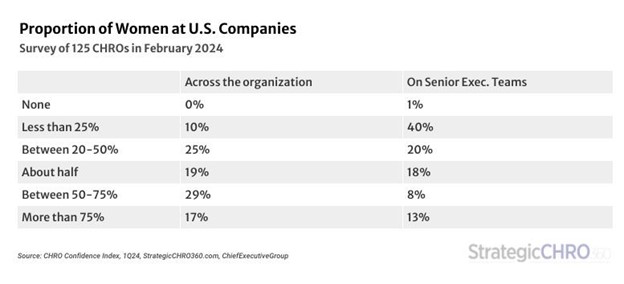Part of the mission of our parent company Chief Executive Group is to provide insights and peer benchmarking data to help you gain a better understanding of trends in the talent marketplace. For that reason, every quarter, our sister site StrategicCHRO360 conducts a brief survey of hundreds of HR leaders across the nation to take their pulse on what’s top of mind, what’s blocking the road and what is shaping America’s workplace.
The Q1 results of our survey, the CHRO Confidence Index, are in—and there’s some good and some bad to take away from the data when it comes to the role of women in leadership.
Let’s start by saying that overall, female representation across U.S. organizations is strong. Two-thirds of the 125 CHROs we polled in late February said their workforce is composed of at least 50 percent women. That’s the good news.
And most departments across the organization appear to be well balanced in terms of gender diversity. More good news.
But digging into the data, we find senior executive teams fall well short of the average, with only 39 percent of organizations reporting at least an equal representation of women in leadership roles. Instead, 41 percent said their C-Suite was composed primarily of men, with fewer than 25 percent women.
“While our overall workforce representation of women is strong, we are focused specifically on increasing representation of women in leadership roles,” said the CHRO of a large, $1-billion-plus industrial manufacturer, highlighting the gap and echoing several other CHROs we polled.
The data also revealed an even greater gap among larger organizations.
For instance, while nearly half (47 percent) of the smaller companies we surveyed (those with less than $100 million in annual revenues) reported having women occupy at least 50 percent of the top executive functions, the same was true for only 28 percent of their larger counterparts (those companies with $100 million or more in annual revenues). In this group, 53 percent of senior leadership teams were composed of less than 25 percent women.
Perhaps more alarming is that for a quarter of the largest companies (those with $1 billion+ in annual revenues), the proportion of women in leadership roles has decreased in the past three years.
Jonathon Harris, CHRO at The People Concern, says the pandemic may have played a role in this downward trend, as a large number of people have had to rethink their lives and priorities. “I have seen that this has interrupted the pipeline of great, qualified women and minorities from being in positions to raise their hand and take promotions they might have tried before the pandemic,” he said.
Ruby Hamacher, managing director with Gallagher’s human resources and compensation consulting practice, says what she sees, anecdotally, is women still stepping into leadership roles, “but they might be in a company that they’re more passionate about, or a company that they feel like already aligns with their personal professional values,” she said. “Maybe they don’t want to work at that Fortune 100 company and work 80 hours a week or whatever that might be. Maybe they want to work at the nonprofit and still be CEO or on the leadership team.”
The Best Person for the Job
The decrease of women among senior leadership teams, though smaller than the increase, remains an alarming stat to report. And while many of the organizations polled for this study said they are working at improving those numbers—including 69 percent of CHROs at organizations of $1bn + who said “it is important that we increase our female representation and development”—they did not specify across which area of the business that improvement would take place.
One of the issues perhaps hindering progress, according to the survey respondents, is the need for organizations to retain the best-credentialed candidate for the job, rather than tick off a box to fit certain demographics, particularly in this labor market.
The People Concern’s Harris says while that’s a logical approach, it’s equally important to try to break from the traditional criteria. “You have to dedicate yourself to interviewing dozens, not just the first 5-10 applicants, and make sure you give chances to those who are capable but possibly with a lesser resume at times,” Harris said. “I don’t think most organizations are making a deliberate attempt to have a bias in their hiring, they are just doing what they feel is safe, and the results are speaking loudly.”
But, he said, there’s also a bigger internal problem that may be more specific to larger companies: the larger an organization is, the more entrenched their internal promotion track and anointed future leaders become, he said.
“A large organization has the resources to take their ‘pick of the litter,’ which often means 90 percent of candidates are ruled out by strict screening criteria,” he said, noting that small companies, in contrast, often have to take risks on untrained or less-experienced candidates. “Most executives at large organizations fit the description of career-minded folks in their 40s, 50s, 60s. Defaulting to hiring similar individuals can be detrimental to diversity because such strict requirements can rule out very bright individuals with lesser specific experience.”
Kathy Carmody, CHRO of Acccomack County in Virginia, said her organization changed some of its recruiting sources targeted at professional women for senior leadership by “advertising via groups tailored to women on social media.”
Beyond recruiting, some of the CHROs in our survey also mentioned the importance of developing your own pipeline of talent, with one of them noting that they key is “providing development ladders focused on existing diverse populations within the workforce to remove barriers and skill gaps to foster internal advancement and growth.”
But Hamacher said there’s another important part of L&D that many companies overlook. “What is even more important is are we building equitable professional development structures and standardizing selection processes.”
For example, she said, how are people being selected for professional development opportunities in the organization? How is someone selected for a high-visibility project or a project that has more access to the C-Suite? Or who gets tapped on the shoulder for a training or to join a meeting? “It is these informal kind of opportunities that actually are going to create the most qualified candidate for any job that comes up for promotion,” she said.
She says that’s why organizations focused on selecting the most qualified candidate may want to look into what the organization’s informal processes are to qualify for positions, particularly among the underrepresented people in the organization. “Do they have equitable, not just equal, but do they have equitable access opportunities?”
And for leadership roles, this can be even more daunting. The process of hiring a senior executive, she said, is often “off the books,” where referrals are preferred over job applicants. “There is no opportunity to increase representation either internally or externally because the opportunity for looking at who’s a qualified candidate is not there,” she said.
Hamacher says the process to getting there isn’t short term, either. It takes time to build programs that will make a sustainable difference. “Look at that entry level role in your organization,” she said. “Does it really need a four-year degree, or can we provide on the job training and consider experience in lieu of a degree?”
By the Numbers
The good news:
- 71 percent of CHROs polled said having female representation is important to their organization.
- 57 percent said they had increased the proportion of women in their workforce in the past three years.
- Two-thirds said their workforce was composed of at least 50 percent women.
The not-so-good-news:
- Only 12 percent of technology teams (those teams assigned to tech-related tasks, not companies operating in the tech industry) are composed of at least 50 percent women.
- Nearly a third of CHROs reported not having a single woman on their organization’s tech team—with another third saying the representation of women on the technology team is less than 25 percent.
- 14 percent of sales teams have no female representation at all—and another 41 percent reported women in sales being a minority.
Also of note:
- Two-thirds of CHROs surveyed said their HR departments are primarily composed of women—with a quarter saying their HR team was composed of women only.
The discrepancies between some of these function areas are interesting to highlight and to Harris, they point to the work that remains to be done to diversify our workforces.
“Right now, if you post for an IT job, 85 percent to 99 percent of the applicants are going to be male in general,” he said. “The same math applies for the demographics of HR roles. It is easy for our brains to make a cookie-cutter mold of ‘what should an HR professional look like’ and hire based on that mold.
“I have heard it said in the past by an otherwise diligent manager: ‘I feel comfortable with (blank) type of employees, and my team does as well, I don’t want to disrupt the chemistry we have.’ These are the moments that HR leaders need to show their skills…It’s too easy to just hire someone who is a comfortable choice.”
Appreciating the value of peer-to-peer learning, Chief Executive Group has created a new initiative that will bring resources to help bridge that gap in the representation—and success—of women in leadership teams. Women Leaders CONNECT, launched in early March, builds on our former Women in Leadership program, by bringing together a diverse community of female business leaders to share their journeys, challenges and triumphs.
Through a private, inclusive and safe network led by an advisory council of female executives across industries and job functions, we’re offering all those interested in making a difference in the fair representation of women in leadership roles access to confidential discussion forums, impactful events led by women who have been there and broken the mold, insightful content, opportunities to help build special interest groups (by industry, job function or other) and the chance to connect 1:1 with other female leaders and develop great mentoring or supporting relationships.
Find out more at WomenLeadersConnect.com and reach out with any questions, suggestions or comments. We’d love to hear from you—and we hope you’ll join us!









